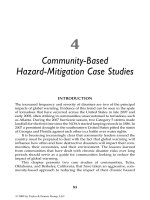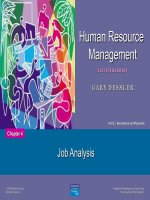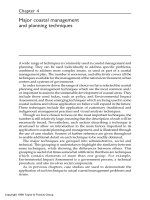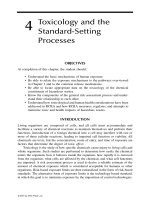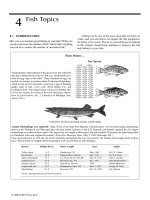Operation management 4th reil sanders wiley chapter 4
Bạn đang xem bản rút gọn của tài liệu. Xem và tải ngay bản đầy đủ của tài liệu tại đây (1.06 MB, 62 trang )
Chapter 4 – E-Commerce
and Supply Chain
Management
Operations Management
by
R. Dan Reid & Nada R. Sanders
3rd Edition © Wiley 2010
PowerPoint Presentation by R.B. Clough – UNH
M. E. Henrie - UAA
© 2010 Wiley
1
Supply Chains & SCM
A supply chain is the network of all the activities
involved in delivering a finished product/service
to the customer
Sourcing of raw materials, assembly, warehousing,
order entry, distribution, delivery
Supply Chain Management is the vital business
function that coordinates all of the network links
Coordinates movement of goods through supply
chain from suppliers to manufacturers to distributors
Promotes information sharing along chain like
forecasts, sales data, & promotions
© 2010 Wiley
2
A Supply Chain can provide strategic
advantage
Why Nokia Is Leaving Moto in the Dust
/>
Nokia's supply-chain management may be the best of any
company in the world. It has a big head start in fast-growing
markets such as China and India. And it has $9.5 billion in
cash and practically no debt, so it can invest far more than
rivals on developing new products or conquering new
markets—and thus build even more intimidating economies
of scale. "We are about to report our billionth customer, so
we must be doing something right," says Anssi Vanjoki, a
Nokia executive committee member responsible for
multimedia devices.
Thanks to those advantages, Nokia's global market share
has climbed to 37%, and some in the industry think it could
hit 40% this year.
Business Week July 19, 2007
© 2010 Wiley
3
Supply Chain Management is
Challenging!
/>
Even More Boeing 787 Delays?
Given assembly and design issues, deliveries of the 787
Dreamliner aren't likely until late 2009. Some dissatisfied
customers are discussing compensation
Deliveries of the Dreamliner are already 10 months behind
schedule and glitches along Boeing's complex global supply
chain slowed production and forced the company to redesign
its wing box. Asked on Apr. 3 about the possibility of yet
another delay, Boeing (BA) spokeswoman Yvonne Leach simply
acknowledged that an announcement of a revised schedule is
coming soon.
Business Week April 4, 2007
© 2010 Wiley
4
A Supply Chain can be a matter of life &
death
/>icle=1
Iran has the second largest natural gas
reservoir of the world but its supply network
has been overwhelmed by high demand. Both
reformists and conservatives are increasingly
asking the president why Iranians are dying
from the cold while sitting on the massive gas
fields.
As much as 22 inches of snow fell in areas of
northern and central Iran in early January, the
heaviest snowfall in more than a decade. Local
2010
Wiley
media have reported ©64
cold-related
deaths
5
© 2010 Wiley
fig_04_01
6
Suppliers
Key Material Decisions
Location
Capacity
Lot sizes; that is, how much to make in a
production run
Inventory (mainly raw material)
Key Information & Related Decisions
Customer orders
Costs, market prices
EDI; web-based;…
© 2010 Wiley
7
Manufacturers/Assemblers
Key Material Decisions
Location
Capacity
Sourcing of components necessary
resources: labor, fuel, equipment
Lot sizes; that is, how much to make in a
production run
Inventory (in all forms)
Key Information & Related Decisions
Supplier shipments
Customer orders
Costs, market prices
© 2010 Wiley
8
Warehouse/Distribution
Centers
Key Material Decisions
Location
Capacity
Inventory (finished & semi-finished)
Key Information & Related
Decisions
Customer orders
Manufacturer/Assembler shipments
© 2010 Wiley
9
Retailers
Key Material Decisions
Location
Inventory (finished goods)
Key Information & Related
Decisions
Customer orders
Shipments from Warehouses/DCs
Market prices
© 2010 Wiley
10
Links
Logistical or Physical
Routes
Modes
Capacities
Cyber
Rates
Tracking of shipments
Orders
Contracts
Regulations
© 2010 Wiley
11
Components of a Supply
Chain
External Suppliers– source of raw material
Internal Functions include – processing
functions
Tier one supplier supplies directly to the processor
Tier two supplier supplies directly to tier one
Tier three supplier supplies directly to tier two
Processing, purchasing, planning, quality, shipping
External Distributors transport finished
products to appropriate locations
Logistics managers are responsible for traffic
management and distribution management
© 2010 Wiley
12
Components of a Supply
Chain
External Distributors transport finished
products to appropriate locations
Logistics managers are responsible for managing the
movement of products between locations. Includes;
traffic management – arranging the
method of shipment for both incoming
and outgoing products or material
distribution management – movement of
material from manufacturer to the
customer
© 2010 Wiley
13
fig_04_02
© 2010 Wiley
14
Sourcing Issues
Which products to produce in-house and
which are provided by other supply chain
members
Vertical integration – a measure of how much
of the supply chain is owned by the
manufacturer
Backward integration – owning or controlling of sources of
raw material and component parts
Forward integration – owning or control the channels of
distribution
Vertical integration related to levels of
insourcing or outsourcing products or
services
© 2010 Wiley
15
Insourcing vs. Outsourcing
What questions need to be asked before
sourcing decisions are made?
Is product/service technology critical to firm’s
success?
Is product/service a core competency?
Is it something your company must do to survive?
© 2010 Wiley
16
Make or Buy Analysis
Analysis will look at the expected sales
levels and cost of internal operations vs.
cost of purchasing the product or service
Total Cost of Outsourcing :
TC Buy = FC Buy + (VC Buy × Q )
Total Cost of Insourcing :
TC Make = FCMake + (VCMake × Q )
Indifferen ce Point :
FC Buy + (VC Buy × Q ) = FCMake + (VCMake × Q )
© 2010 Wiley
17
Example 1: Make-or-Buy analysis- Mary and Sue, have decided to
open a bagel shop. Their first decision is whether they should make the
bagels on-site or by the bagels from a local bakery. If they buy
from the local bakery they will need airtight containers at a fixed
cost of $1000 annually. They can buy the bagels for $0.40 each.
If they make the bagels in-house they will need a small kitchen at
a fixed cost of $15,000 annually. It will cost them $0.15 per bagel
to make. The believe they will sell 60,000 bagels.
Mary and Sue wants to know if they should
make or buy the bagels.
FCBuy + (VCBuy x Q) = FCMake + (VCMake x Q)
$1,000 + ($0.40 x Q) = $15,000 + ($0.15 x
Q)
Q = 56,000 bagels
Since the costs are equal at 56,000 bagels
and Mary and Sue expect to use 60,000
bagels, they should make the bagels in-house
© 2010 Wiley
18
© 2010 Wiley
table_04_02
19
Critical Factors in
Successful Partnership
Relations
Critical factors in successful partnering
include;
Impact – attaining levels of productivity and
competitiveness that are not possible
through normal supplier relationships
Intimacy – working relationship between two
partners
Vision – the mission or objectives of the
partnership
© 2010 Wiley
20
Critical Factors in
Successful Partnership
Relations
Have a long-term
Share a common vision
orientation
Are strategic in nature
Share short/long term
plans
Share information
Driven by end-customer
needs
Benefits
Share
risks andof Partnering
Early supplier involvement (ESI) in the design process
opportunities
Using supplier expertise to develop and share cost
improvements and eliminate costly processes
Shorten time to market
© 2010 Wiley
21
table_04_03
© 2010 Wiley
22
Suppliers & Partnerships
/>6.htm?chan=search
The key to Stallkamp's first revolution was the emphasis on
cooperation among carmakers and their suppliers. Rather than
dictate lower parts prices to suppliers, he offered incentives. If
suppliers found a way to save a dollar, Stallkamp let them keep
50 cents. And instead of playing competitors off against one
another, he pledged loyalty to Chrysler's incumbent suppliers, as
long as they could meet contract terms.
The idea is to create alliances of suppliers who have agreed to
centralize the control of their supply-chain operations. Suppose
that a dozen companies are involved in the manufacturing and
assembly of a car seat. Today, the small fry make and deliver
parts to a larger integrator, who assembles the seat and delivers
it to a General Motors Corp. (GM ) or a Ford Motor Co. (F ) The
staff at each of these companies watches over the flow of goods,
© 2010 Wiley
manages delivery dates, and tends to their clients.
23
Suppliers & Partnerships
/>6.htm?chan=search
Q: Why do we need to change the way we deal with the supply
chain?
A: [Stallkamp] In a nutshell, I still believe that supply chains need
to be actively managed by someone. When I was at [Chrysler],
we had a concerted policy to help our suppliers and cooperatively
manage the supply chain. Now, the OEMs [original equipment
manufacturers--i.e., the auto makers] seem to be moving away
from active management to more passive management. When
that happens, I believe it's up to the supply base itself to try to
find another alternative
© 2010 Wiley
24
© 2010 Wiley
table_04_01
25

